Perfect Temp Smoked Baby Back Ribs: A Thermal Exploration
Brisket, pork butt, ribs. These are the holy trinity of BBQ, and with good reason. These collagen-rich cuts thrive in the low, smoky heat of the BBQ cooker, slowly melting into gelatin-infused, bark-encrusted savory treats. And in no other BBQ cut do you get the bark-to-meat ratio that you do with ribs: slabs of ribs, dry rubbed and spicy; whole racks of ribs, glazed with tangy-sweet sauce; riblets for gnawing while you pick at the last of your coleslaw. They are wonderful.
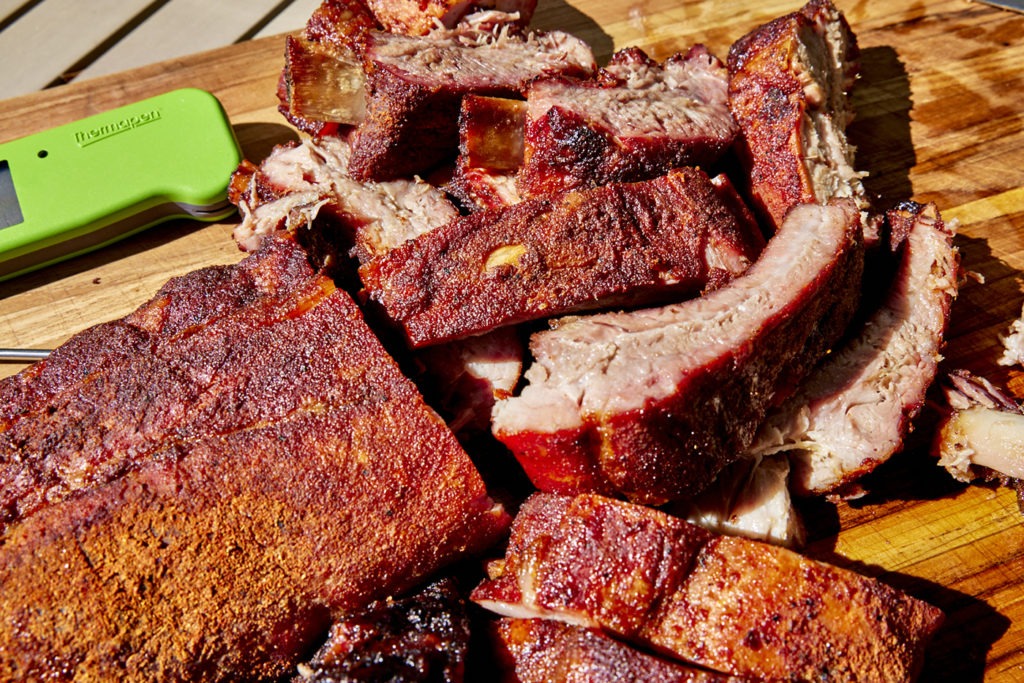
Ribs are done at 190°-205°F (88°-96°C)
While ribs are decidedly a part of the barbecue pantheon, there is a division to be made there. Spare ribs—anything but spares to those who know!—are the athletic, good-looking, more muscular big brother in the rib family. Yet, you shouldn’t overlook the tender, shorter, amiable little brother! Baby back ribs are often relegated to the realm of ‘pop’ food, thanks in large part to a certain jingle that I’m not going to mention. Since baby back ribs’ introduction into fast-casual dining in 1997, some BBQ meisters have turned their noses up at this cut of meat; but we’re here to tell you that there is still a place at the BBQ table for baby back ribs!
“At home, I love baby back ribs”
—Meathead Goldwyn
Most BBQ organizations encourage the use of spare ribs for competition, but baby back ribs are excellent for the home. In this article, we’ll look at the thermal experience of baby back ribs on their way to competition-style results. We’ll be using Smoking-Meat.com‘s guidelines for the meat and the multi-channel Signals BBQ Alarm Thermometer with W-Fi to track the temperature through the cook.
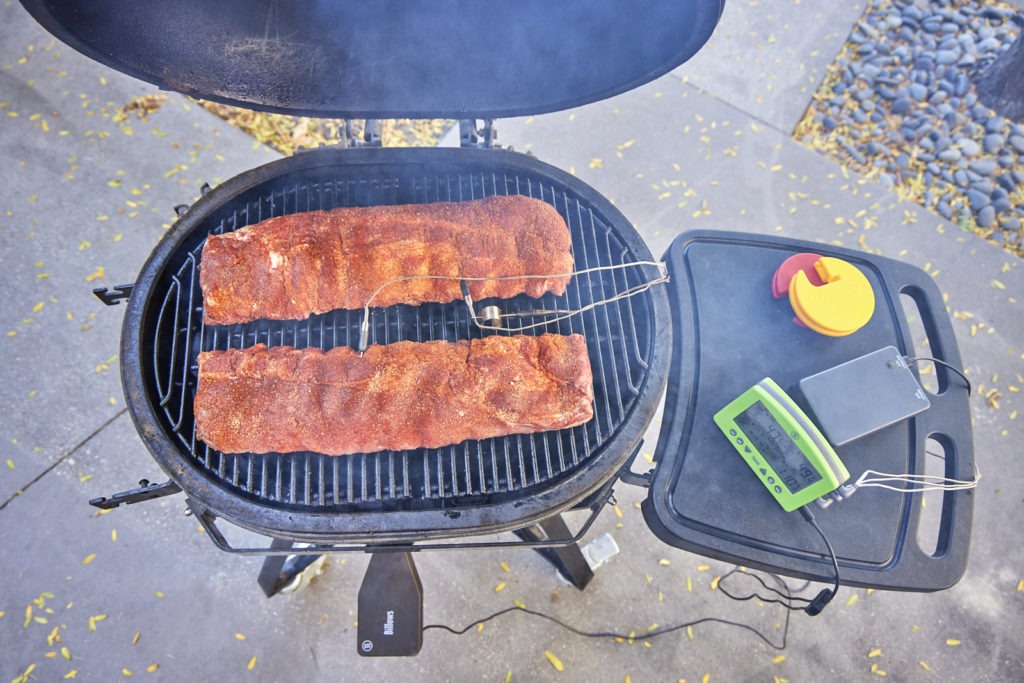
Contents:
- What are baby back ribs?
- Cooking baby back ribs
- Baby back rib temperature
- Smoked baby back ribs recipe
- More about cooking ribs
Baby Back Ribs Background
Spare ribs vs. baby back ribs
The popularity that baby back ribs do have has been helped greatly by their name, which sounds tender and succulent. The name suggests tenderness far better than the term “loin ribs” does—loin is not a ‘pretty’ word—and yet, that is precisely what they are. The loin lies along the convex side of the ribs. In fact, if you eat bone-in pork chops, you are getting baby back ribs for the bone. Spare ribs, by comparison, are found further down the sides of the hog and are coated on the convex side with belly meat. They are part and parcel of the same structure but are from different sections of the whole.
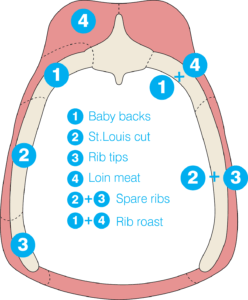
As you can see, the ‘back’ in ‘baby back’ refers to their location, high up on the pig’s back. ‘Baby’ simply comes from their smaller size—it has nothing to do with the age of the pig!
Cooking baby back ribs
So what does their location on the hog mean for cooking baby backs? For one thing, they’re still ribs, and that means connective tissue. You can’t just slap these babies on the grill and cook them to a food-safe 145°F (63°C) or they’ll be tough as nails. Slow cooking will dissolve that collagen.
But what happens when you cook things past 155°F (68°C)? That’s right all the water in the muscle fibers is wrung out by the denaturing proteins. And when that newly-released water finds its way to the surface of the meat it starts to evaporate and you get the infamous stall.
To overcome the stall, take a page from brisket cookery and wrap the ribs, this time with aluminum foil. Every pitmaster has their own technique, but most follow something along the lines of what Steven Raichlen calls the 3-2-1 method. This guideline for reaching the proper temperature means cooking for about three hours without a wrap, then for two hours wrapped tightly in foil, then for another hour unwrapped again. But note that this time structure is only a guideline for achieving thermal processes. You need to get the ribs into a collagen-melting temperature zone—above 170°F (77°C)—and keep them there long enough to tenderize.
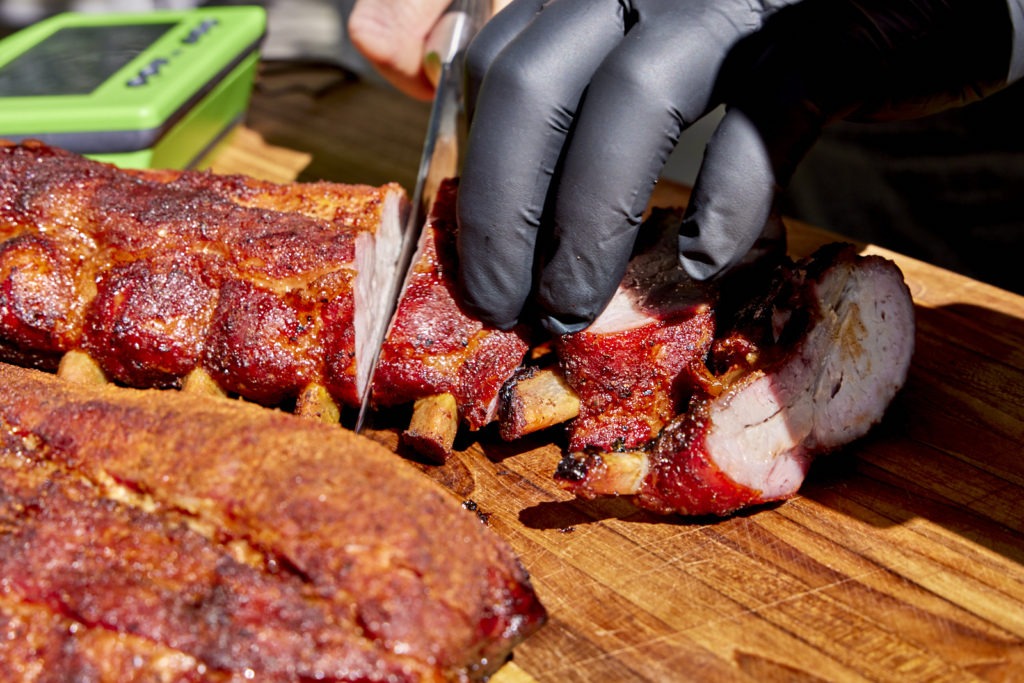
You could just cook the ribs bare until they reach a temperature that indicates enough collagen has broken down, but that takes a while. Wrapping them prevents evaporative cooling (the stall), allowing your ribs to get to temperatures where collagen melts even faster. By the time your ribs reach 200°F (93°C), they should be tender enough to eat. All the wrapping and unwrapping serves to achieve a proper bark and to speed the journey to the proper temperature.
For baby backs, Jeff Phillips of Smoking-Meat.com calls for a shorter 5-hour version of this method, but the concept is the same: cooking them wrapped the whole time would make the bark soggy and sad, but wrapping for only part of the cook yields tender, barky ribs that have spent enough time in the melting-temp zone.
So much for the rib meat: what about that thick layer of meat on top of the baby backs? That is loin meat. Loin meat is, in essence, a pork ribeye and is susceptible to drying out. It is low on collagen and also rather lean, so cooking it to any temperature above 150°F (66°C) will overdo it. This is where baby backs have a failing. It is tempting to get super-meaty baby back ribs with a thick layer of loin, but that meat is liable to overcook. Rather than looking for extra-meaty ribs, look for those that have a relatively thin layer of loin meat. The transition layer from rib to loin has the connective tissue needed to rehydrate the meat during a longer cook.
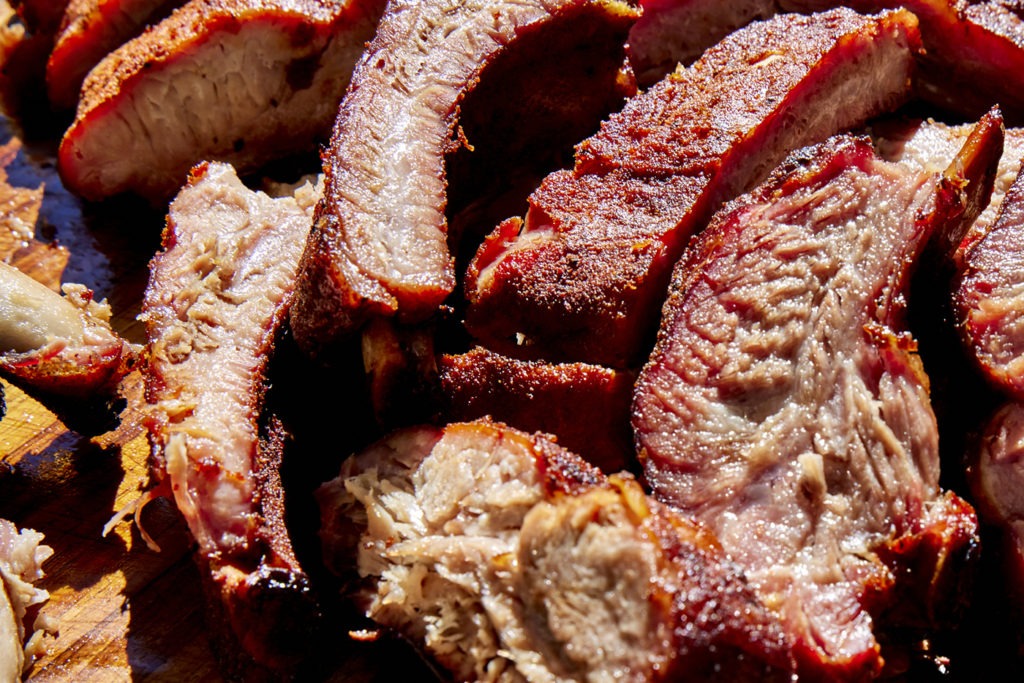
Baby back rib cooking temperature
How we get there, of course, is its own question. We want a temp that is relatively low. We want to keep the smoker at about 250°F (121°C) for the duration of the cook. To help keep that temp on target, you can use Billows BBQ Control Fan in conjunction with Signals. Signals reads the temperature and runs the fan to increase or limit the temperature. You don’t have to think about it anymore!
Baby back rib doneness temperature
The ribs, as we’ve discussed, are full of collagen, and collagen dissolution is a function of both time and temperature. This means that the way we approach a finishing temperature matters almost as much as the temperature itself. Jeff Phillips recommends a rib temp of 195°F (91°C), right in line with ThermoWorks approved rib temp of 190-205°F (88-96°C), but he proposes two methods of arriving there, one of which will give you fall-off-the-bone tender ribs, the other of which will get you a competition-style rib that can pass the bite test: This means the rib must be bitten into to get the meat off the bone, while a perfect bite mark must remain behind without any extra meat tearing away from the rib along with your bite. The meat must pull away easily from the bone.
“I’ll show you how to get them as tender as what you find in the restaurant if that’s what you’re after.”
—Jeff Phillips
For competition style, use a timing formula of 3-1-1, three hours bare, one hour wrapped, then one hour bare again. (Note, for fall-off-the-bone ribs—for those that prefer them that way—use 2-2-1. The longer time in the moist environment of the foil allows the collagen to break down more quickly—there is more time without evaporative cooling!)
Towards the end of the bare-ribs phase, you will notice that the temperature increase starts to slow. That’s the stall starting to happen. Wrap those ribs with foil to speed things back up.
As soon as the ribs are wrapped, their internal temperature will start to climb again, up to and beyond the recommended minimum of 195°F (91°C). Once they are unwrapped again, the meat temperature will actually drop as the water that has accumulated on the surface starts to evaporate. This means that the ribs will stay in the collagen-melt zone without more heat going into them.
Thermally speaking, it’s a lot like the trick of using a cooler with wrapped ribs that are mostly cooked to allow them to finish “melting.” The cooler-method is a great way to improve the texture of your meat, but it wreaks havoc on your bark. By allowing evaporative cooling to occur in the smoker, we can achieve melty ribs that aren’t overcooked and that have a craveable bark. Thermodynamics!
Below is a graph from the cook that we did, using Signals to monitor the temperatures. You can see the stall starting around 160°F (71°C). Then you can see the temp drop when we removed the probe for wrapping, after which the temperature starts to climb much faster. When we unwrap the ribs, the evaporative cooling takes over and the temperature dips, but starts to recover before we take them off the heat for good.

You should also verify both the internal temperature and the rib tenderness using your Thermapen ONE.
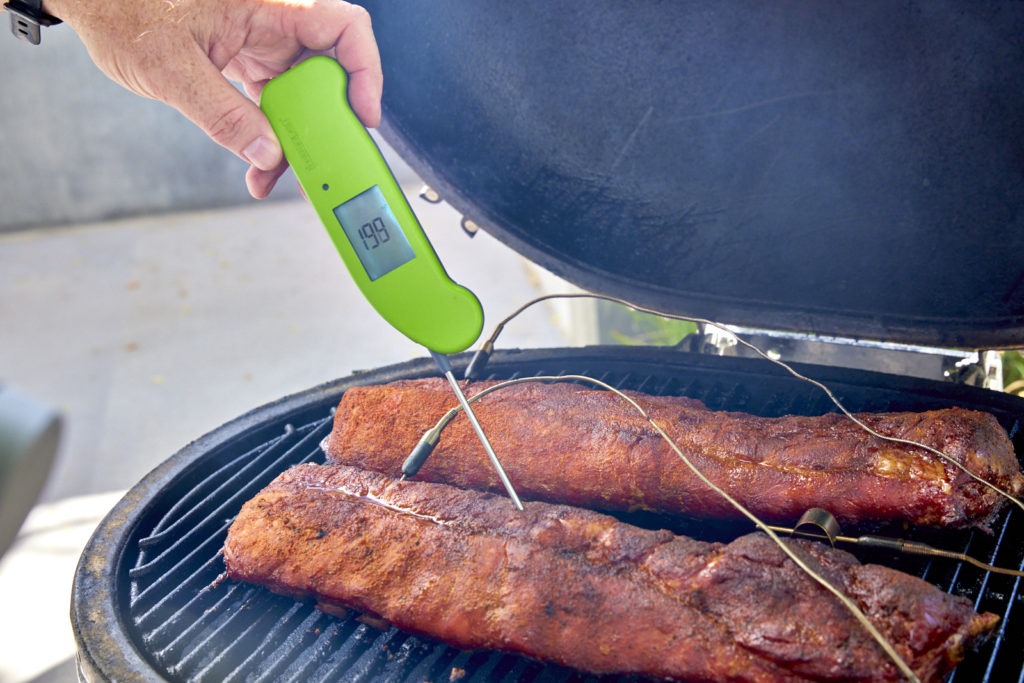
Baby back ribs deserve their place in barbecue royalty. They are delicious, fun, and pretty easy to make! Use good thermometers like Signals and Thermapen ONE and remember the wrapping method: 2-2-1 for soft, 3-1-1 for competition style. Give them a try this weekend!
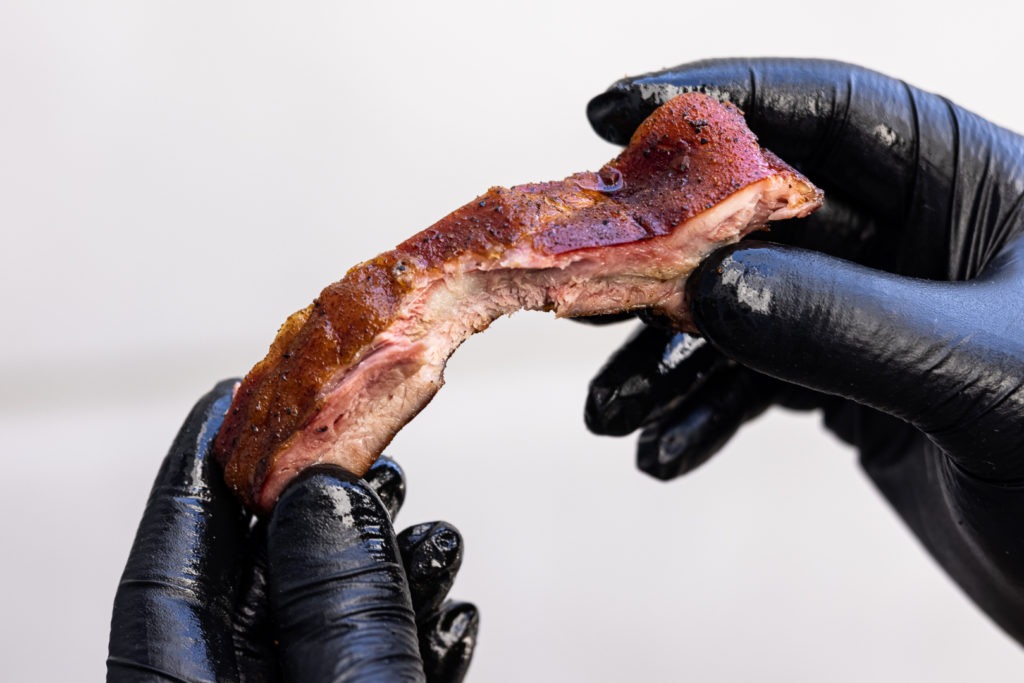
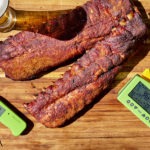
Perfect Temp Smoked Baby Back Ribs: A Thermal Exploration
Description
From Jeff Phillips at Smoking-Meat.com
Ingredients
- 1 rack, baby back ribs
- 3–4 Tbsp mustard
- Your favorite BBQ rub, as needed
- Your favorite BBQ sauce, optional
Special equipment: two large sheets of heavy-duty aluminum foil.
Instructions
- Preheat your smoker to 250°F (121°C) using Signals and Billows to set and control the temperature.
- Peel the membrane from the back of the rack of ribs. This facilitates bark production on the underside of the ribs, but is ultimately optional. (Or, you can ask your butcher to remove it for you.)
- Slather the ribs in mustard. (Jeff Phillips says this step is optional…I highly recommend it!)
- Apply rub generously to the ribs, pressing to help it adhere to the mustard.
- Place ribs in the smoker. Insert a 2.5″ needle-probe into the ribs. Do this between the bones if the ribs have less meat or in the thickest part of the meat if they are very meaty. The needle probe is thin enough to fit into the rib meat without touching bone.
- Set up your Signals to monitor the temperature.
- Smoke the ribs for 3 hours for a competition-style finish, 2 hours for fall-off-the-bone ribs.
- When the time has expired, wrap the ribs well in aluminum foil. The temp should be somewhere near the 170°F mark.
- Return the baby back ribs to the smoker. Re-insert the probe.
- Smoke for 1 hour (competition) or 2 hours (fall-off). During this time, see that the ribs reach the target temp of 190°-205°F (88°-96°C). (Set the high-temp alarm on Signals to let you know when you get there.)
- Remove the ribs-package from heat and unwrap.
- If you want glazed, sticky ribs, now is the time to brush them with BBQ sauce. If you want to keep them “dry” just go on from here.
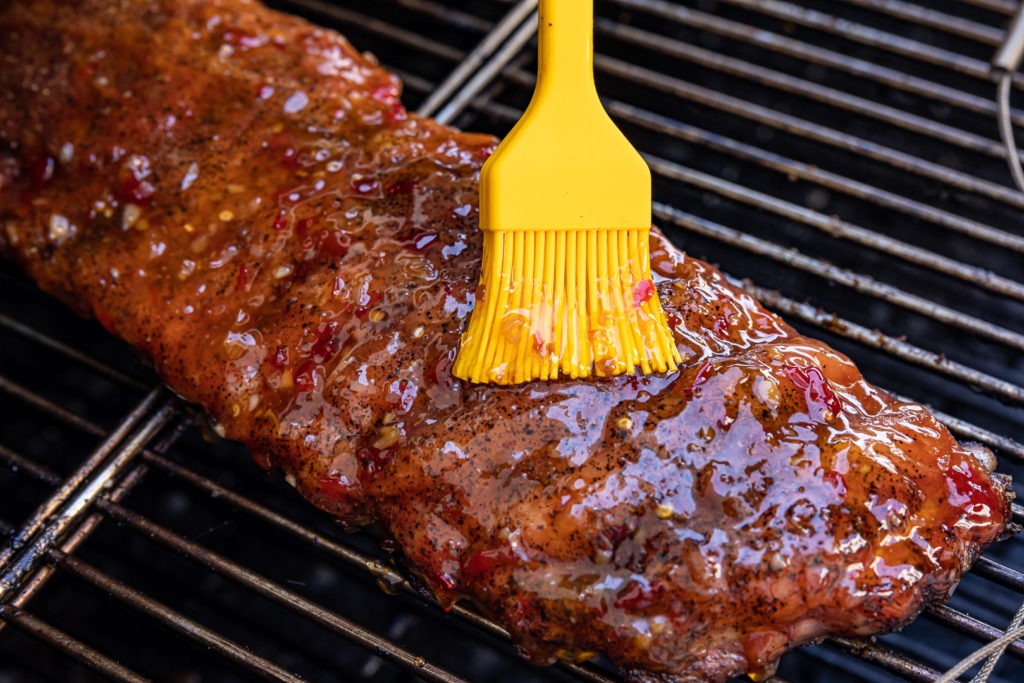
- Put the ribs back in the smoker. Replace the probe.
- Allow the ribs to cook for 1 final hour. You will see the temp drop during this time, then rise again somewhat.
- Remove the ribs from heat. Let cool enough to handle.
- Cut the ribs up and enjoy!
To learn more about cooking ribs, check out some of our other posts:
- “Candied” wide-cut ribs
- Asian sticky ribs
- Cooking spare ribs in a barrel cooker
- All about pork ribs
- Saucy cherry-soda-glazed ribs
- How to cook competition-style ribs


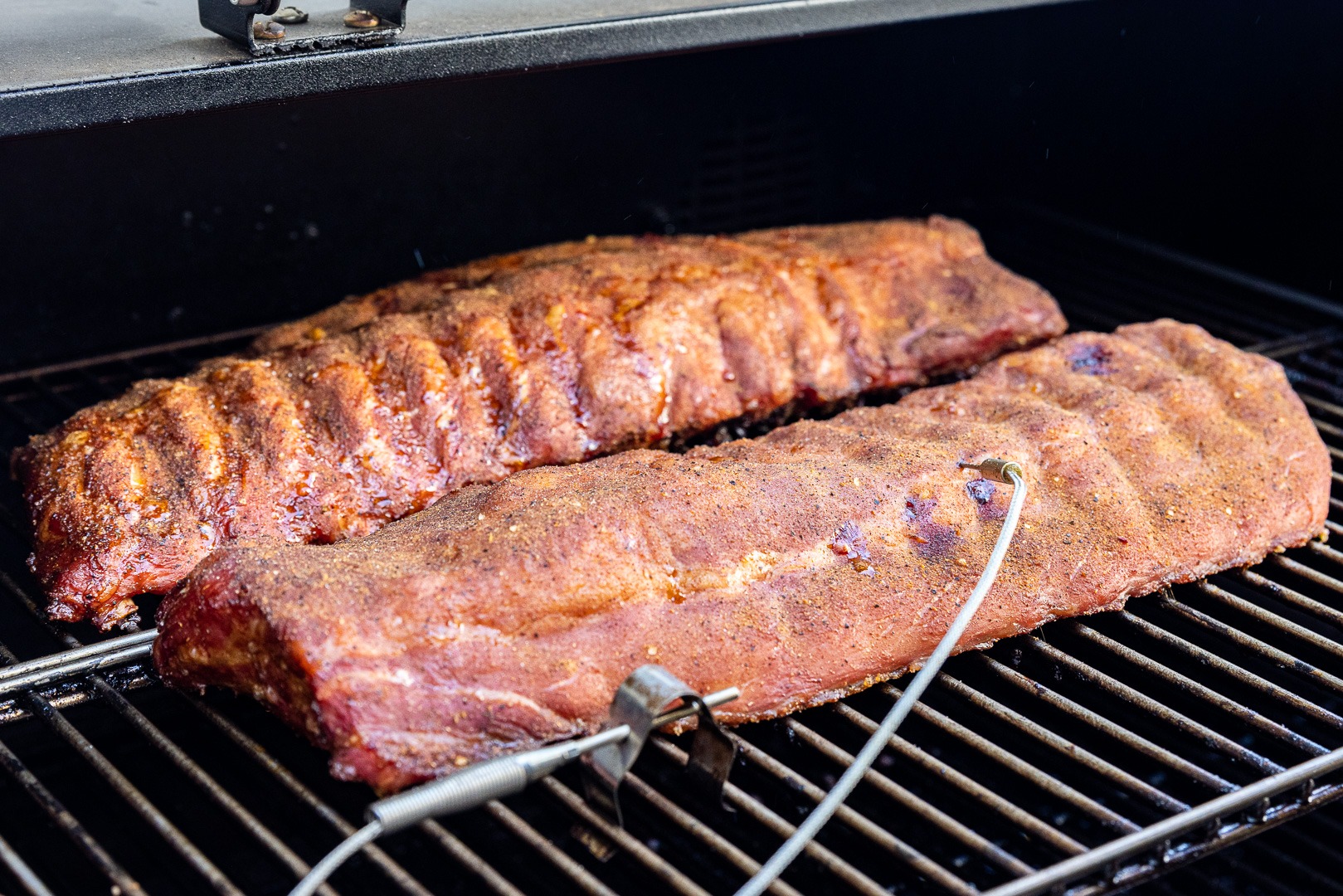
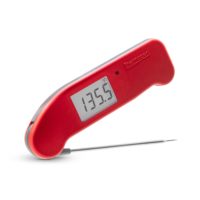
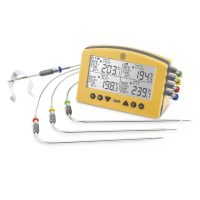
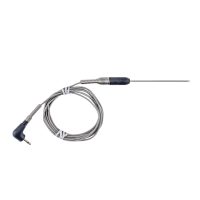
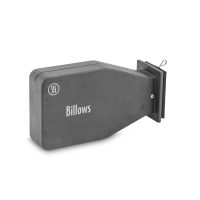
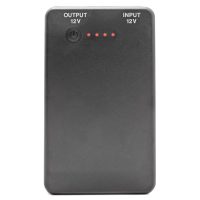
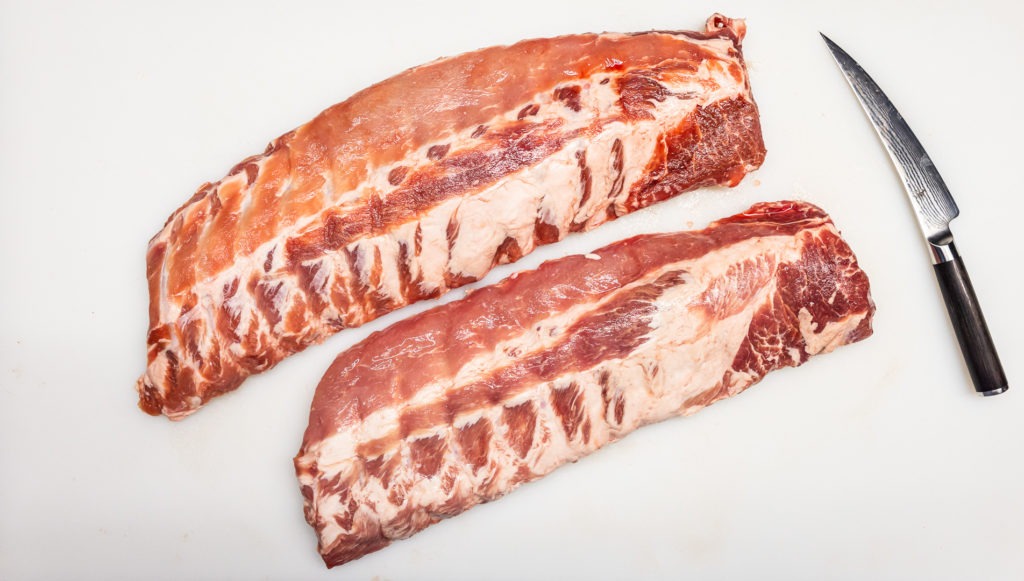
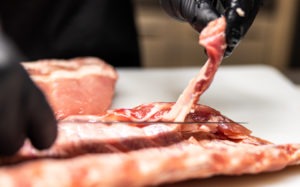
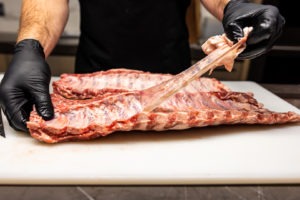
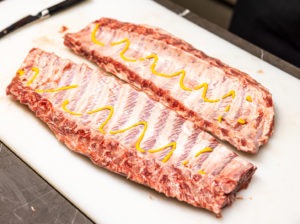
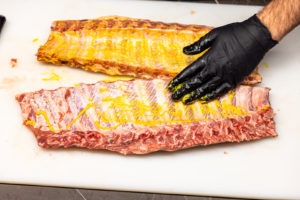
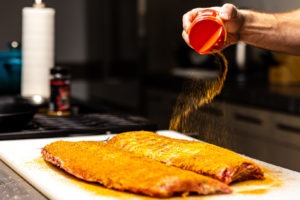
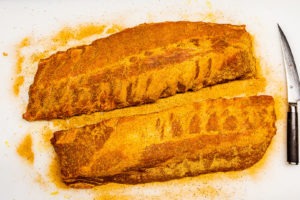
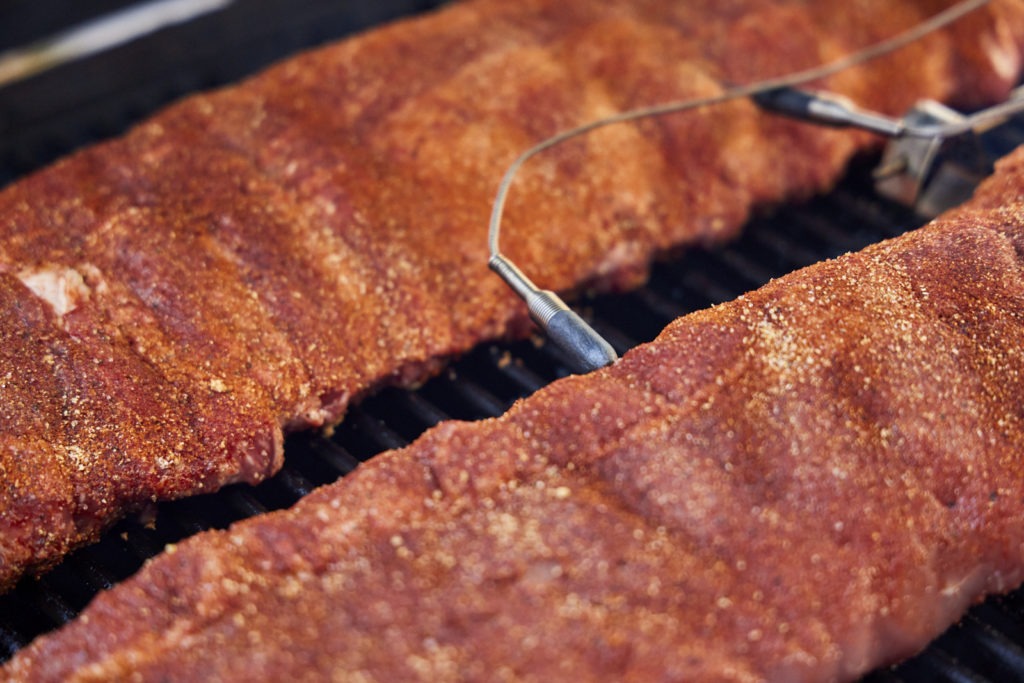
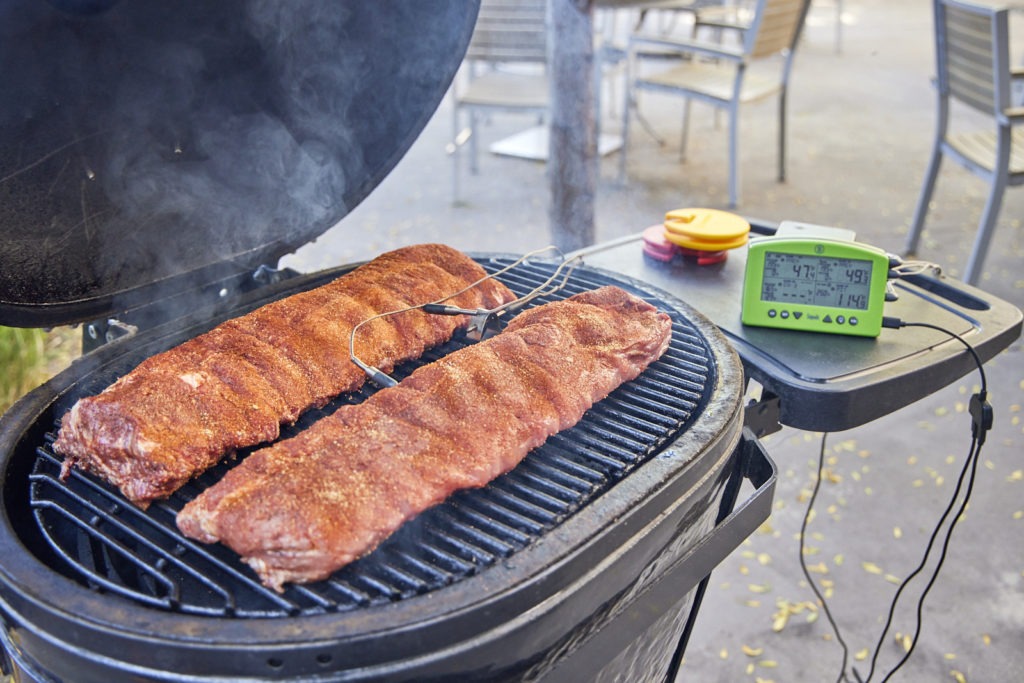
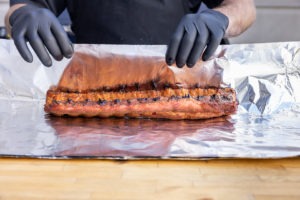
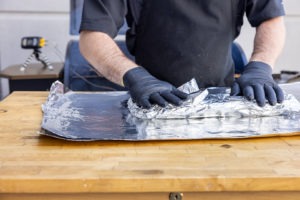
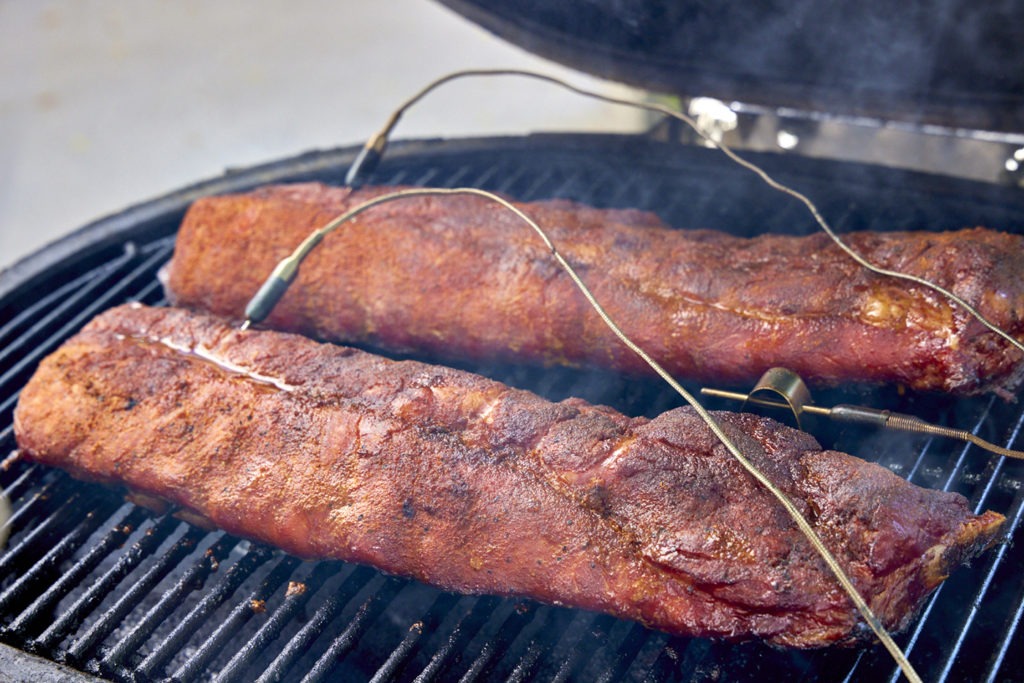
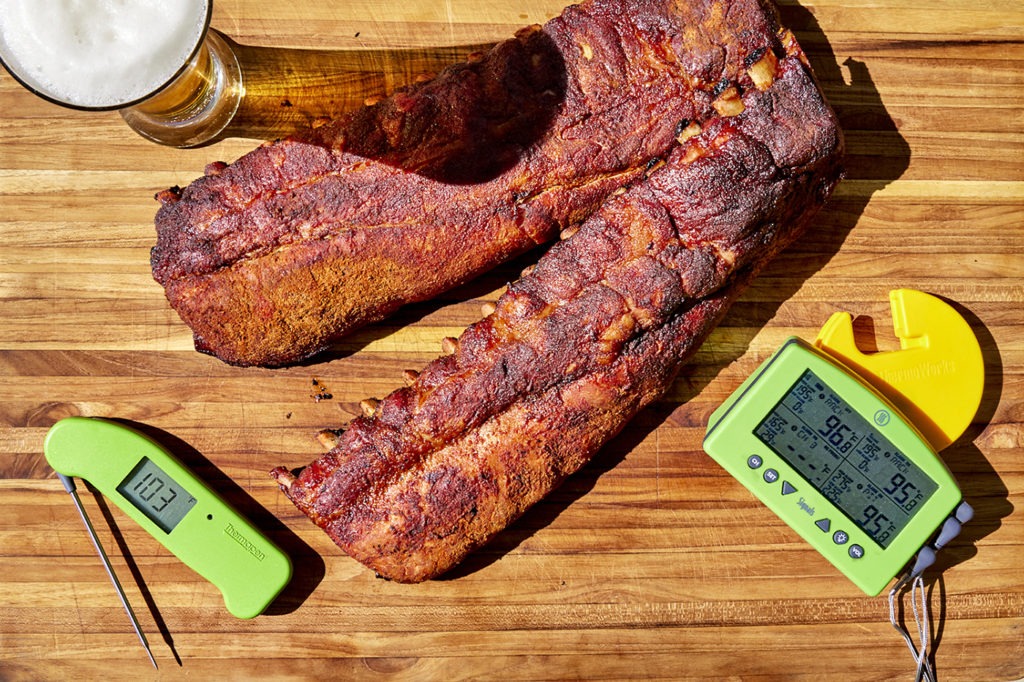
For me, fall-off-the-bone ribs are for amateurs… the same people who would boil ribs think they should be able to slide the bone out before eating it with their fork and knife… BBQ BLASPHEMY!!! I made ribs the other night, no foil wrap, I just let them smoke and left them alone… about 7 hours at 235 degrees, until they came up to 200 degrees. They were perfect. The bite you took came cleanly off the bone, left a perfect bite mark, and no other meat came (or fell) off. I didn’t even use any sauce… sauce would have ruined the perfect flavor and bark my homemade rub (I call it Cedar Creek Candy) made on the ribs. They were GLORIOUS.
Michael,
I agree about the sauce. I personally love the flavor of a great rub + pork. But I know there are sauce fans out there. Anyone have a sauce recipe that will change my mind?
I will have to try the slower, naked ribs method some time. I’ve always wrapped them, but if I’m not in a hurry, i should try it. Thanks for the tip!
Happy cooking!
My secret sauce secret is to add tamarind paste to your sauce recipe. It gives a bit of tang and flavor.
I’ve heard of that once before but never tried it. Sounds delicious!
That matches a tip from Meathead Goldwyn. I couldn’t find it in any stores and ended up ordering some from Amazon.
Blackberry ketchup is worth a try!
I also prefer not to sauce my ribs, but my wife like them sauced. As a compromise, I take Sweet Baby Ray’s original sauce and thin in out with Nakano Seasoned Rice Vinegar 1:1 and then thin that out with water about 3:1. What I get is a very thin glaze that tacks up nicely in about 10 minutes if you want it a little wet, or let it go for about 20 minutes to dry it out completely, leaving a nice looking, shiny top coat over the bark without imparting too much of the flavor of the SBR base. You can probably substitute any sugary/ tomato-y BBQ sauce and do the same. I also use this finishing sauce on Smoked Shotgun Shells, Armadillo Eggs, and Texas Twinkies.
Try the Tuffy Stone Cool Smoke barbecue sauce. It’s great on ribs, even better on chicken. You can find the recipe on his web site.
I like a variation of the Myron Mixon rib sauce. Sweet and Tangy.
Michael you are right about “fall off the bone” and sauce on perfectly smoked ribs; same goes for a Boston butt! Sauce ruins the taste of the meat. I wonder if these same people put steak sauce on steak?
I like a little Heinz 57 on the side to smear some of my steak in, sometimes. It doesn’t mean my steaks are bad, it means I like a little Heinz 57 on the side to smear some of my steak in, sometimes.
I like the way you smear!
I like higher heat on St Louis ribs. Mustard, rub and on grill at 275-300 degrees for approx.
5 hours. Mist the tops every 45 minutes or so with mix of apple juice and cider vin. or your choice of… No wrap. At approx. the 4 1/2 hr mark or 190-195 degrees reduce heat 240-250, I sauce
to glaze, or leave dry until 200-205 degrees. No wrap,nothing else. Competition style 5 hour
ribs.
I couldn’t have said it better.
Mike,
There are numerous ways to get from point A to point B, and point B is often a different place for different people. Don’t knock those that don’t have the same point B that you do.
Rich
What is your recipe for your Cedar Creek Rub?
Sir,
I love the 7 hour idea for smoking BB ribs. But when you mentioned fall off the bone was for amateurs, I was a bit confused because yours came “off the bone cleanly”.
I pull off the “membrane” before applying the rub. Confirm if you do that?
I know boiling ribs definitely helps them fall off the bone but I’m trying to stay away from that idea.
Tonight I’m trying a 450 sear for 15 minutes and slow cook for 1& 1/2 hrs at 200 degrees, then wrap in foil for last 2 hours.
We’ll see how this turns out tonight🙏👍😋
By “for amateurs” I just mean that they are not what pro’s do for competition. Most people that I know prefer fall of the bone for home eating! And yes, we remove the membrane before adding the rub.
Very nice article Martin, I liked that you explained the difference between competition style and commercial style ribs. I don’t know what marketing guru came up with “falling off the bone”, but in my opinion falling off the bone is way overcooked. As a competition judge, I have had rib meat fall off the bone and into my lap; major fail on the cook teams part. Also, one last thing the mustard; do not use Dijon, the mustard acts as a binder for the rub; if you are going to use mustard plain yellow mustard works great, it is less expensive, and you will not taste the difference.
Qholic,
First, thank you for reading and commenting: it’s good to know we have a judge out there that thinks we are saying the right thing.
And you are right about the mistard, when I think about it. Great call!
Say, as a Q judge, do you ever see baby backs, or is it all spare ribs all the time?
What would you do differently for St. Louis style ribs? Like Michael Vidal, I do NOT like falling-off-the-bone ribs. I also slow-smoke for many hours over apple wood or cherry wood, having used a dry rub.
Thank you
David,
St Louis style ribs are basically spare ribs minus the tips. They are meatier and thicker and need more time to tenderize. 3-2-1 is a pretty safe bet for them, if you are going to wrap them. Otherwise I’d bet on about 8 hours. I love cherry for ribs.
Happy cooking!
I teach BBQ classes in Argentina and usually tell the students, yep you can use mustard and a binder if you want, but I usually just wet them down with apple juice before applying the rub.
That’d be especially great with pork ribs!
I am not a sauce fan either, but sometimes I do, to change things up or to try a sauce. I don’t like sloppy slimy sauced ribs so to combat that I preheat the sauce. I does not cool the ribs as much and it will thicken more.
I have been doing some experimentation with #-#-.5ish if I do use a sauce at the end. The reason for the .5ish is that I crank the temp up to about 300F in an attempt to get the sugars in the sauce more caramelized and firm things up. I did this on my last couple of racks with a glazing sauce and was not disappointed even though I am a rub only fan.
I like some sauce as an option, but not slathered like at some chain place restaurant, which I don’t go to anyway, but see in their ads.
Lately, I am mixing Trader Joe’s Carolina Gold with some other basic bbq sauce, like Famous Dave’s, Newman’s. I saute up some minced onions, garlic, and shallots, and add a touch more ACV and ketchup. There’s no wrongly served bbq just like there’s no best pizza. Though too many people here think there is.
If you want to save a ton of time and get just as good results, look at the Hunsaker Vortex Smoker. I’ve been using one for over 2 years and my ribs are done and tender in around 2 hours. I can do either wrapped or unwrapped in the same time. I hang them in the Vortex smoker so the are cooked from both sides at the same time, usually around 190 in about an hour at between 250 & 275. If I want to rap them I pull them around an hour and throw them back on for another hour. Other wise I just let them hang for another half hour to an hour until I get it to temp. Since the Vortex turns the barrel into a convection oven no water is needed. The Vortex plate is 11 gage steel and an the juices from the meat hit it, it’s vaporized and the meat is smoked in it’s own juices. I’m a big fan of hickory, but sometime do add other woods. No BBQ sauce needed for these ribs.
Awesome tips and explanation!
Joe,
Thanks!
Happy cooking!
I followed the directions by temperature for fall off the bone style but got competition results. Any idea why?
Here’s what I did: I set the smoker to 230, and smoked the ribs to 170, that only took an hour. Then wrapped the ribs and tried to smoke them for another two hours, but again, it only took an hour to get to 195. Seeing the trend for half the time, I smoked again with the glaze , and without foil, for 30 minutes. Temp got up to about 180.
For fall off the ribs, should I just decrease the temp next time? Or maintain the temp and continue to smoke for the full recommended two hours?
Thanks in advance!
-Noob smoker
Edd,
I’d maintain the temp and cook for the full two hours. There will be significant collagen transformation in that time. I hope the comp-style were still tasty!
Thanks for your reply Martin. Using the actual times worked perfectly. Times seem to work better for me than temps 🙂
I am not looking to enter my ribs in a competition! I am looking to please my family and they love the fall off the bone, melt in your mouth consistency of baby backs. So I aim to please. 🙂
I’m with ya…IMHO, folks that call for the bite, are more fascinated with the process of smoking…than with the end results on your taste buds….I call them smoker snobs.
Yessir! I was a professional chef, and I tried to make my kids “delicious meals” within a family’s budget–since love’s the best ingredient, right? Anyway, I was working feverishly one evening to make chicken marsala or picatta or something when my eldest daughter came to me, “Ya know… Dad… Ya don’t always have to make it … so… fancy”. Haha! I could tell she didn’t want what I was making. That’s when I truly learned the lesson: “Give the people what they want!”
Nobody cares if we like our steak a perfect medium rare or if we KNOW that filet mignon cooked well-done is destroying it. We gotta give the people what they want:)
My kids loved the 4th of July baby backs last night!
Try a 1:1 mix of your favorite sauce and apple butter. Add a smidgen of honey to sweeten if desired.
I promise you won’t be disappointed.
That sounds DELICIOUS.
First, I always enjoy reading about the chemistry that you will include. One thing that I am not sure about is why so many people, including this recipe, start by putting mustard on the ribs. I have not seen someone suggest an alternative for those that do not have an affinity for mustard. Is it just to get the spices to adhere to the ribs (or meat in general)?
Jc,
Yes, it acts as a binder. The emulsifying powers of mustard help the bark form up well. That being said, it isn’t necessary. You can just apply rub to the meat. I have also seen people use a very light coat of mayo!
I am confused by this temperature profile. I smoke my baby backs unwrapped for 2.5hours at 275F and they only peak at 140F to 145F. No way I can see smoker at 225 getting the ribs to 155F in that same time. Please help me understand why this is. Also I don’t like wrapping but I love fall off the bone style. I wrap to hit temps but the steaming effect makes the meat pot roasty and I hate it. If I don’t wrap it would take forever to get to 205. I worry it will dry out doing a 5+hour cook.
A 5 hour cook, wen done properly, will not dry out the ribs. at 250°F they get pretty close to 155°F—if not higher—in 2–3 hours. the wrap does get steamy, yes, but that’s why the second unwrapped part of the cook is important. It dried the surface and gives the ribs more of that wood-smoker feel. They come out juicy and delicious every time.
So, what temp should the ribs be at the end of the 2-2-1 cycle (baby backs)? I hit about 165 after 2 hours, then about 190 after 2 hours wrapped, but only about 165 again after the unwrapped hour (dropped to about 140 shortly after unwrapping). There was a lot of juice in the foil upon unwrapping but the final result was dryer meat than expected. And, not fall off the bone. Now, the ribs might have been too cold to start – they were about 60 degrees. Is the target temp (190-205) for the end of the wrapped phase or the final temp? I think I would have had very dried out ribs if I had tried to hit 190 at the very end.
It’s the target temp for the final phase. You may go higher than it in the wrap, but when you unwrap you should try to get back up to about 195°F. There will be a massive cool off, but the move back up through the temperatures will go fairly quickly. as soon as the surface water is evaporated, the rib temp will rise.
I’m from West Texas. We use a mixture of mesquite and oak, preferably post oak from the Texas Hill Country. I use no mustard and my own NO SUGAR spicy dry rub. I always cook at 225 degrees on my custom built offset smoker using the 3-1-1 timing, raising the temperature to 300 in the final hour. NO SAUCE EVER! IMHO, sauce is for amateurs and bad cooks! Enjoy the unparalleled flavor of fine pork!
Always enjoy articles like this with very specific and reasoned commentary and analysis. Told my wife I want to make some ribs this weekend.
One thing not mentioned was should they be on direct or indirect heat? Always a point of discussion.
Lastly, my contribution to the BBQ sauces. My fave is 1 bottle each of Rufus Teague Blazing hot, Touch’Heat and Honey Sweet. Mix in a pan with a darker sweet beer like Shiner Bock or Honey sweet and bring to a boil until the bubbles go away.
Yields a spicy yet sweet in the finish sauce that is not too thick and good for multiple applications without burning.
Indirect heat….mostly. There are some smokers, barrels, for instance, that have no barrier between the meat and the heat, but those usually have a bit of distance between the ribs and the heat source, which acts as a barrier in a way. I always do indirect as direct heat dries the ribs out more.
That sauce combo sounds delicious!
So I live in a high rise building and don’t have a smoker or BBQ. I’ll be cooking my ribs in a standard home oven. I’m sure plenty of others can relate to my plight!
Can anyone give me their thoughts and/or tips on what process I should use?
Treat your oven just like a smoker. Same temps, same times!
My unfailingly successful process for baby back ribs is to use a mustard base plus rub, then smoke them for 2 hours 45 minutes at 270 degrees. I then take them out and sprinkle on some more rub. The result is perfect bark and delicious, extremely tender but not falling off the bone ribs.
If I want to “hold” the done ribs, what is the best way? Wrap in butcher paper and place in 140F warming oven (or warmed cooler)? How long can I keep them in a “warmer” before serving? 1-2hrs?
1-2 hours at least, I’ve done 3-5 without any trouble.